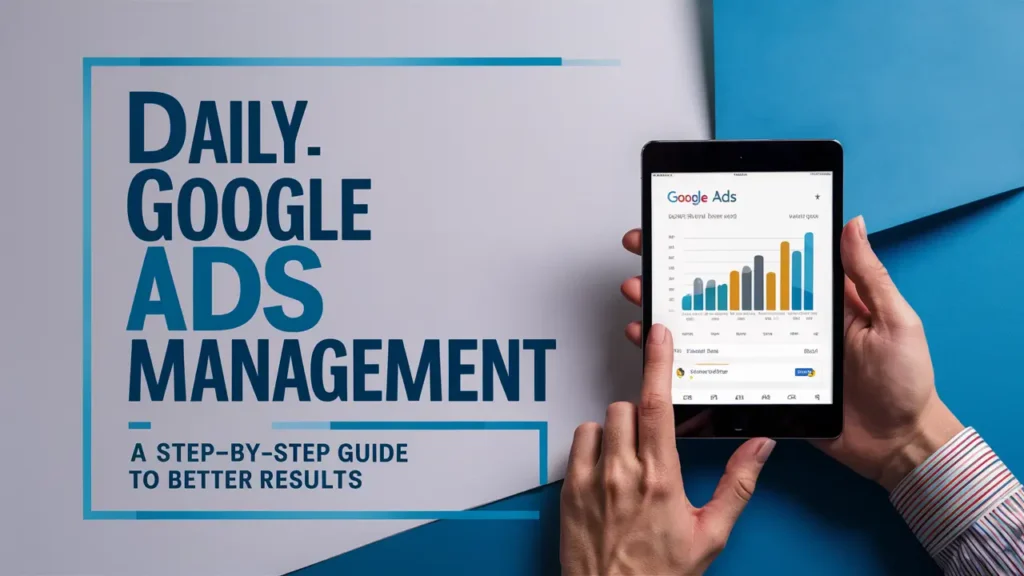Daily Google Ads Management: A Step-by-Step Guide to Better Results
Daily Google Ads Management: A Step-by-Step Guide to Better Results

1. Start with a Daily Check-In
Begin your day by reviewing the performance of your Google Ads Management campaigns from the previous day. Look at key metrics such as click-through rate (CTR), conversion rate, and cost per conversion to assess how your campaigns are performing. Identify any areas that may require immediate attention, such as underperforming ads or keywords with high costs and low conversions.
2. Monitor Key Metrics Throughout the Day
Throughout the day, continue to monitor the performance of your Google Ads Management campaigns. Keep an eye on important metrics like CTR, conversion rate, and cost per conversion to ensure that your campaigns are on track to meet your goals. Use this real-time data to make informed decisions about your campaigns and adjust your strategy as needed.
3. Make Adjustments and Optimizations
Based on your daily performance data, make adjustments and optimizations to your Google Ads Management campaigns to improve their effectiveness. This may include pausing underperforming ads or keywords, adjusting bids, or updating ad copy to better align with your goals. By regularly optimizing your campaigns, you can improve their performance and achieve better results.
4. Test New Strategies and Tactics
Continuously test new strategies and tactics in your Google Ads Management campaigns to identify what works best for your business. This may include testing different ad copy, landing pages, or targeting options to see what resonates most with your audience. By testing and iterating on your campaigns, you can refine your approach and improve your overall ROI.
5. Review and Analyze Performance
At the end of each day, take the time to review and analyze the performance of your Google Ads Management campaigns. Look for trends and patterns in your data to identify areas for improvement. Use this information to inform your strategy moving forward and make data-driven decisions about your campaigns.
6. Utilize Ad Scheduling
Ad scheduling, also known as dayparting, allows you to specify certain times of day or days of the week when you want your ads to be displayed. By analyzing your campaign data, you can identify peak times when your target audience is most active and adjust your ad schedule accordingly. This can help you maximize your ad visibility during times when your audience is most likely to convert, improving your overall campaign performance.
7. Implement Geographic Targeting
Geographic targeting allows you to show your ads to users in specific locations, such as cities, regions, or countries. By targeting your ads to specific geographic locations, you can ensure that your ads are seen by users who are most likely to be interested in your products or services. This can help you improve the relevance of your ads and increase your chances of attracting qualified leads.
8. Monitor Competitor Activity
Keeping an eye on your competitors’ ads and strategies can provide valuable insights that you can use to improve your own campaigns. Pay attention to the ad copy, offers, and keywords that your competitors are using, and look for opportunities to differentiate your ads and offer more compelling value to your audience. By staying informed about your competitors’ activities, you can stay ahead of the curve and make informed decisions about your own campaigns.
9. Stay Up-to-Date with Industry Trends
The digital marketing landscape is constantly evolving, with new trends and technologies emerging all the time. To stay competitive, it’s important to stay informed about the latest industry trends and best practices. Subscribe to industry blogs, attend webinars, and participate in online forums to stay up-to-date with the latest developments in the world of digital marketing. By staying informed, you can identify new opportunities and stay ahead of the competition.
Conclusion
Daily Google Ads Management is a key component of a successful PPC strategy. By following this step-by-step guide to daily management, you can improve the performance of your Google Ads Management campaigns, achieve better results, and maximize your ROI. Incorporate these practices into your daily routine to take your Google Ads Management campaigns to the next level.
Read our secrets to Google Ads Quality Score with our comprehensive guide. Learn how to improve ad relevance, increase click-through rates, and optimize landing page experience.


